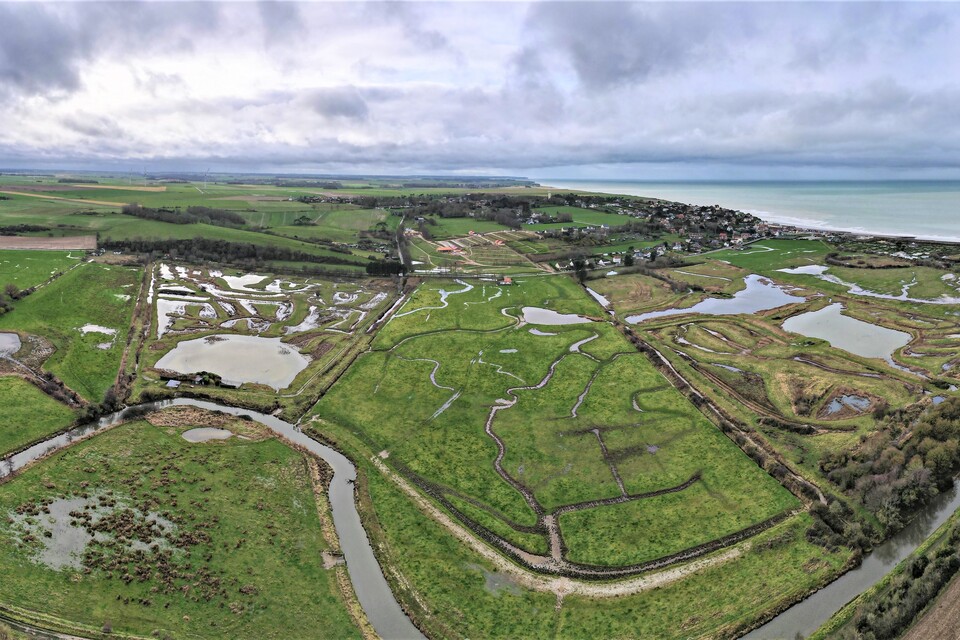Environment Agency

- New guide provides framework for the future of coastal communities
- Transferrable model aimed at policymakers, contractors and community leaders
- Practical tools and lessons learnt to support further climate adaptation
As the impacts of climate change continue to be felt around the world, coastal communities are especially vulnerable to the increasing risks caused by rising sea levels and extreme weather events.
To help communities adapt to these challenges by joining forces with nature, the Promoting Adaptation to Changing Coasts (PACCo) project - a pre-emptive climate adaptation, habitat restoration, and infrastructure improvement initiative - has published a free-to-access, practical guide. This details the key elements to consider when delivering similar much-needed schemes.
A 27million EU Interreg project led by the Environment Agency, PACCo is the first of its kind to demonstrate large-scale estuarine adaptation across two countries (England and France). The guide is therefore designed to be a transferable tool to empower, assist, and encourage community leaders, policymakers, contractors and stakeholders to improve resilience to rising coastal challenges through nature-based solutions.

The PACCo guide
The new resource provides step-by-step guidance on implementing the PACCo model and shares the methodology and lessons learnt from the projects conception to completion. This includes tips on stakeholder engagement, funding and natural capital, design and construction, risk assessment, long-term monitoring, and adaptation planning.
It also includes extensive examples of successful implementation at the schemes two flagship sites in the Lower Otter Valley (East Devon) and Sane Valley (Normandy, France) to help others understand how the model works in practice.
An internationally replicable strategy that is already demonstrating its aims to build flood and erosion resilience, reverse habitat and biodiversity loss, and increase carbon capture and socioeconomic value, it is estimated that around 70 estuarine sites in northern France and southern England alone may benefit from a similar model.
Dr Lydia Burgess-Gamble, Senior Project Manager at PACCo and the Environment Agency said:
We are really excited to share our practical guide with the wider coastal community. PACCo is a powerful example of how collaborative efforts and proactive, innovative and balanced interventions can tackle complex and shared environmental challenges to achieve meaningful change.
We believe the PACCo guide and model will leave a lasting, positive, and practical legacy not just in transforming and safeguarding our two sites in Devon and Normandy, but for other coastal and estuarine locations in urgent need of building vital resilience to the impacts of climate change.
The guide has been developed from years of cross-border research, specialist expertise and delivery experience. We hope it will serve as a framework for the future of our coasts and encourage others to adopt a similar pre-emptive and collaborative nature-based approach to adaptation planning and coastal management.
By acting now, sharing learning, raising awareness, providing the right tools, and engaging stakeholders, we can develop adaptation strategies that are effective, sustainable, and equitable, and that provide significant benefits to people, wildlife and the environment.

The Saane Valley in France was adapted at the same time as the Lower Otter in England
A marker of its early success, PACCo has recently been shortlisted as a finalist for the Flood & Coast Excellence Awards 2023. The accolade recognises initiatives across the flood and coastal risk management (FCRM) sectorthat have made outstanding contributions towards protecting coastal communities and environments.
The winners will be announced at the Flood & Coast Conference 2023 (6-8 June) on 7 June, following a full day of specialist seminars and expert speakers. This includes a session on Delivering Nature-based Solutions, which will showcase examples of innovative schemes leading the way in mainstreaming natural methodologies.
In this seminar, Dr Lydia Burgess will be presenting on the PACCo project joined by speakers and other case studies from CIWEM Rivers and Coastal Group, Enfield Council, National Flood Forum, Mott MacDonald, and Wyre Borough Council.
The PACCo Guide and summary are available for free download via (www.pacco-interreg.com):
A wide range of additional and supporting resources can also be found on the website including science reports, newsletters, blogs, and videos.
Background
Works undertaken as part of the PACCo project include:
The Lower Otter Restoration Project (Otter Valley):
- A 70-metre breach in embankments to reconnect the River Otter to its historic floodplain
- Restoration of 55ha of intertidal wetland habitat
- Construction of a 30-metre span flood resilient, raised road and road bridge
- Construction of a new footbridge to ensure continuity of the South West Coast Path
- Raising and improving of 3.7km of public footpaths
- Creation of a new network of natural creek channels
- Relocation of a popular cricket club away from the floodplain
- Securing and capping of a former domestic landfill
- Planting of over 23,000 trees
- Ongoing species monitoring
- Educational visits and presentations
Basse Sane 2050 project (Sane Valley):
- A 10-metre breach in embankments to reconnect the River Sane to its historic floodplain
- Restoration of 55ha of intertidal wetland habitat
- Construction of a new wastewater treatment plant
- Relocation of a major campsite away from the floodplain
- Planting programmes
- Ongoing species monitoring
- Educational
